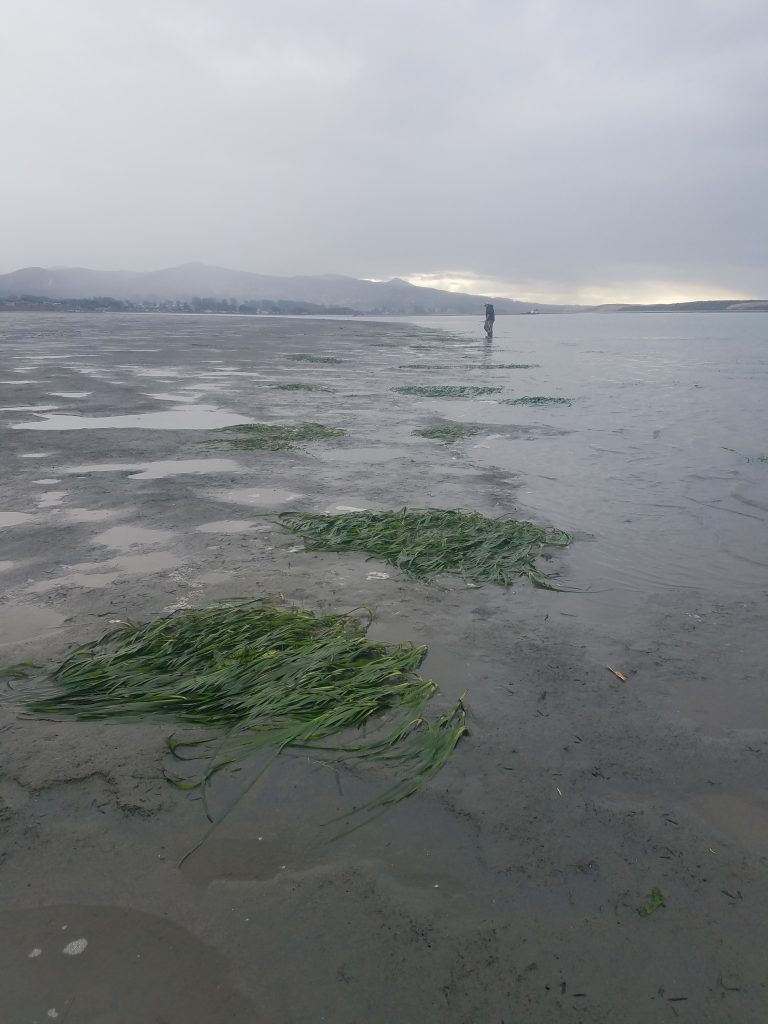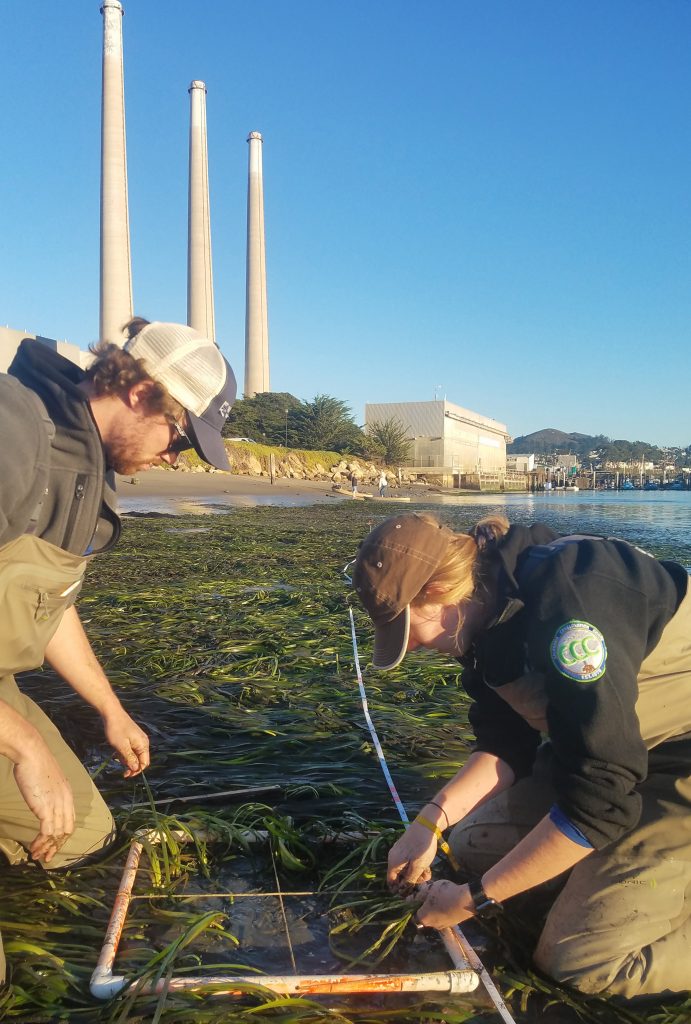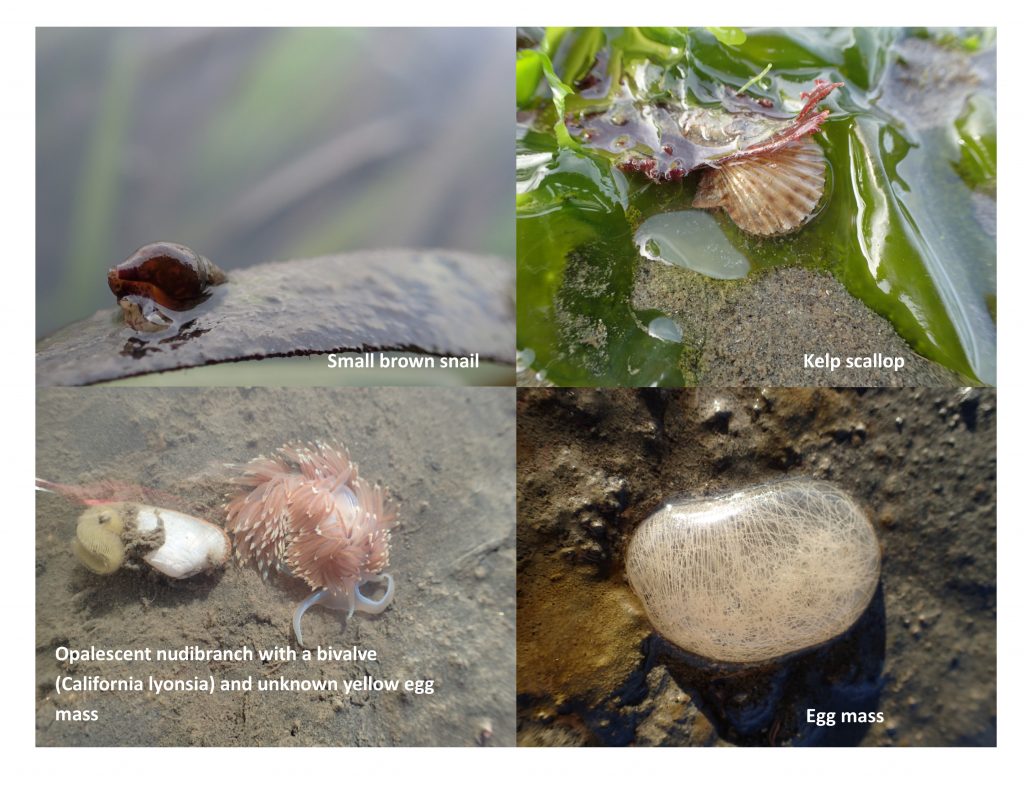Fulfilling our mission to protect and restore the Morro Bay estuary for people and wildlife requires a lot of hard work in the field. At the Estuary Program, that often entails doing research, restoration, and monitoring work out on the estuary and along the creeks that feed into it. Read on to see what we’ve been up to during the past month.
Eelgrass monitoring
Each fall, we monitor eelgrass on our permanent transects. These transects are sample areas across the bay where eelgrass has grown historically. We chose the specific locations of the transects to represent different zones in the bay and capture the differences between these zones. They range from Coleman Beach, near the mouth of the bay, south to Pasadena Point, near the back of the bay.
This December, we got out to 5 out of 6 of them (it was too windy on the winter solstice for us to make it all the way back to Pasadena Point!).
If you have been out kayaking or paddleboarding on the bay recently, you might have seen some new patches of eelgrass appearing.

The eelgrass shoot density of the transect at Coleman Beach is about the same as it has been the past three years. Eelgrass in the forebay has remained fairly stable throughout the decline, but we did see lower densities here in some years.

We will report more once we complete all of the surveys. To see results from past years and, look at the 2017 Eelgrass Report.
Wildlife sightings on the bay
Here is a list of species we spotted in December while out in the bay.
- California lyonsia—a small bivalve. We have been seeing more of these than in past years. We are seeing them in the highest densities in the area just south of State Park Marina.
- Kelp scallop (Leptopecten latiauratus)
- Opalescent nudibranch (Hermissenda crassicornis)
- Bulla snail (Bulla gouldiana)
- Bat star (Patiria miniata)
- Spotted cusk eel (Chilara taylori)—we often see these when we do eelgrass surveys around sunset.
- Ochre sea star (Pisaster ochraeceus—this species was among the hardest hit by Sea Star Wasting Syndrome)
- Unknown yellow egg mass (potentially that of California lyonsia)
- Unknown white egg mass
- Leopard shark (Triakis semifasciata)
- California Sea Lion (Zalophus californianus)
- Harbor Seal (Phoca vitulina)
- Southern sea Otter (Enhydra lutris nereis)

Creek Monitoring
We worked on getting our sediment sampler ready for the upcoming winter. This involved doing a test deployment during one of the early December rain events. This year, we will be focusing our sediment monitoring efforts to our station on Chorro Creek at Canet Road.
We will not be deploying our samplers for the rain coming our way this weekend, but we will be watching the rainfall totals and seeing how the creeks respond. Check out this blog post to see some of the resources we use to track the weather here on the central coast.
Rainfall totals
The San Luis Obispo County gauge on Canet Road recorded 1.22” of rain for the month of December, bringing the total up to 3.77” for the current water year.
Upcoming Event: Art Show
- Flowing Estuary to Living Sea paintings by SLOPE
- February 1 through March 31, 2019 at the Morro Bay State Park Museum of Natural History
- Opening reception on Saturday, February 2, from 1 p.m. to 4 p.m.
Come see paintings of our beautiful coastline from Ragged Point to Oso Flaco by the talented and environmentally-conscious artists of SLOPE. A number of paintings will focus on Morro Bay and the surrounding watershed.
A portion of the proceeds for this show will benefit the Central Coast State Parks Association and the Morro Bay National Estuary Program. We hope to see you there!
Help protect and restore the Morro Bay estuary
- Donate to the Estuary Program today and support our work in the field, the lab, and beyond.
The Estuary Program is a 501(c)3 nonprofit. We depend on funding from grants and generous donors to continue our work. - Support us by purchasing estuary-themed gear from ESTERO. This locally owned and operated company donates 20% of proceeds from its Estuary clothing line and 100% of Estuary decal proceeds to the Estuary Program. Thank you, ESTERO!
- Purchase items from the the Estuary Program’s store on Zazzle. Zazzle prints and ships your items, and the Estuary Program receives 10% of the proceeds. Choose from mugs, hats, t-shirts, and even fanny packs (they’re back!) with our fun Estuary Octopus design, our classic Estuary Program logo, or our Mutts for the Bay logo.
Thank you for your support!